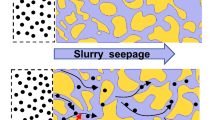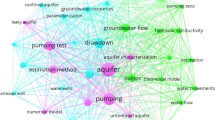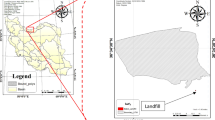Abstract
Karst aquifers exhibit a dual flow system characterized by interacting conduit and matrix domains. This study evaluated the coupled continuum pipe-flow framework for modeling karst groundwater flow in the Madison aquifer of western South Dakota (USA). Coupled conduit and matrix flow was simulated within a regional finite-difference model over a 10-year transient period. An existing equivalent porous medium (EPM) model was modified to include major conduit networks whose locations were constrained by dye-tracing data and environmental tracer analysis. Model calibration data included measured hydraulic heads at observation wells and estimates of discharge at four karst springs. Relative to the EPM model, the match to observation well hydraulic heads was substantially improved with the addition of conduits. The inclusion of conduit flow allowed for a simpler hydraulic conductivity distribution in the matrix continuum. Two of the high-conductivity zones in the EPM model, which were required to indirectly simulate the effects of conduits, were eliminated from the new model. This work demonstrates the utility of the coupled continuum pipe-flow method and illustrates how karst aquifer model parameterization is dependent on the physical processes that are simulated.
Resumé
Des aquifères karstiques présentent un système d’écoulement double caractérisé par l’interaction de domaines de conduits et de domaines matriciels. Cette étude examine le cadre du couple écoulements par conduits-écoulement en continuum pour modéliser un écoulement karstique dans l’aquifère Madison de l’Ouest du Dakota du Sud (USA). L’écoulement couplé par conduit et matrice est simulé dans un modèle régional aux différences finies sur une période de 10 ans. Un modèle de milieu poreux équivalent existant a été modifié pour inclure les principaux réseaux de conduits dont la localisation ont été imposés par des données de traçage coloré et analyse de traceurs environnementaux. Les données de calage du modèle incluent les niveaux piézométriques mesurés dans les puits d’observation et estimation de la décharge de quatre sources karstiques. Relativement au modèle milieu poreux équivalent, la correspondance avec les niveaux piézométriques observés a été améliorée de façon substantielle ave l’addition des conduits. L’inclusion de conduits a permis une distribution de la conductivité hydraulique plus simple dans le continuum matriciel. Deux des zones de grande conductivité dans le modèle milieu poreux équivalent, qui étaient nécessaires pour simuler de façon indirecte les effets des conduits, ont été éliminées du nouveau modèle. Ce travail démontre l’utilité de la méthode de couplage écoulement en continuum-écoulement par conduits et illustre la dépendance du paramétrage d’un module aquifère karstique aux processus physiques simulés.
Resumen
Los acuíferos kársticos exhiben un sistema de flujo dual caracterizado por conductos interactivos y dominios de la matriz. Este estudio evaluó el marco continuo acoplado conducto - flujo para modelar el flujo de agua subterránea en karst en el acuífero Madison del oeste de Dakota del Sur (EEUU). El flujo del conducto acoplado y la matriz fue simulado dentro de un modelo regional de diferencias finitas sobre un período de transición de 10 años. Se modificó un modelo equivalente de medio poroso (EPM) ya existente para incluir las principales redes de conductos cuyas ubicaciones fueron limitadas por datos de trazadores colorantes y análisis de trazadores ambientales. Los datos de calibración del modelo incluyeron mediciones de las cargas hidráulicas en los pozos de observación y estimaciones de la descarga de cuatro manantiales kársticos. En relación con el modelo EPM, el cotejo de las cargas del pozo de observación fue sustancialmente mejorado con la adición de conductos. La inclusión del flujo de conducto permitió una distribución más simple de la conductividad hidráulica en el continuo de la matriz. Dos de las zonas de alta conductividad hidráulica en el modelo EPM, que fueron requeridas para simular indirectamente los efectos de los conductos, fueron eliminadas del nuevo modelo. Este trabajo demuestra la utilidad del método del acoplamiento continuo en el conducto – flujo e ilustra como la parametrización del modelo del acuífero kárstico depende de los procesos físicos que son simulados.
摘要
岩溶含水层展示了具有相互制约的通道和基质领域特征的的双重水流系统。本 研究评估了用于模拟美国南达科卡州Madison 含水层岩溶地下水流耦合的连续体管流框架。在区域有限差分模型内模拟了10 年过度周期的耦合的通道和基质水流。对已有等同的多孔介质模型进行了改良, 包括了主要通道网, 其位置受到染料示踪资料和环境示踪分析的限制。模型校准包括观测井处测量的水头资料及四个岩溶泉排泄量的估算值。相对于已有的等同多孔介质模型, 通过 增加管道的长度, 与观测井水头相匹配的情况大幅改进。包含通道水流可以得到基质连续体内简单的水力导水系数分布情况。已有等同的多孔介质模型钟的两个高导水率带需要间接模拟通道的影响, 这两个高导水率带在新的模型中被剔除。这项工作展示了耦合连续体管流方法的实用性, 描述了岩溶含水层模型参数化怎样取决于被模拟的物理过程。
Resumo
Os aquíferos cársicos exibem um sistema de escoamento dual caraterizado por domínios de conduta e de matriz que interagem entre si. Este estudo avaliou a abordagem acoplada contínuo tubo de fluxo para modelar o fluxo cársico de águas subterrâneas no aquífero Madison de Dakota do Sul ocidental (EUA). O fluxo acoplado de conduta e de matriz foi simulado dentro de um modelo de diferenças finitas regional para um período transitório de 10 anos. Modificou-se um modelo existente de meio poroso equivalente (MPE) para incluir as redes de condutas maiores, cujas localizações foram constrangidas por dados de traçadores corantes e análise de traçadores ambientais. Os dados de calibração do modelo incluíram potenciais hidráulicos medidos em poços de observação e estimativas da descarga de quatro nascentes cársicas. Relativamente ao modelo do MPE, o ajustamento às observações dos potenciais hidráulicos nos poços foi substancialmente melhorado com a adição de condutas. A inclusão do fluxo por condutas permitiu uma distribuição mais simples das condutividades hidráulicas no contínuo da matriz. Duas das zonas de alta condutividade no modelo do MPE que foram necessárias para simular indiretamente o efeito das condutas foram eliminadas do novo modelo. Este trabalho demonstra a utilidade do método acoplado contínuo tubo de fluxo e ilustra como a parametrização do modelo de aquífero cársico depende dos processos físicos que são simulados.







Similar content being viewed by others
References
Anderson MT, Driscoll DG, Williamson JE (1999) Ground-water and surface-water interaction along Rapid Creek near Rapid City, South Dakota. US Geol Surv Water Resour Invest Rep 98–4214, 99 pp
Arfib B, de Marsily G (2004) Modeling the salinity of an inland coastal brackish karstic spring with a conduit-matrix model. Water Resour Res 40:W11506
Ashton K (1966) The analysis of flow data from karst drainage systems. Trans Cave Res Group of Great Britain 7(2):161–203
Atkinson TC (1977) Diffuse flow and conduit flow in limestone terrain in the Mendip Hills, Somerset (Great Britain). J Hydrol 35:93–110
Back W, Hanshaw BB, Plummer LN, Rahn PH, Rightmire CT, Rubin M (1983) Process and rate of dedolomitization: mass transfer and C-14 dating in a regional carbonate aquifer. Geol Soc Am Bull 94(12):1415–1429
Bailly-Comte V, Martin JB, Jourde H, Screaton EJ, Pistre S, Langston A (2010) Water exchange and pressure transfer between conduits and matrix and their influence on hydrodynamics of two karst aquifers with sinking streams. J Hydrol 386:55–66
Bauer S, Liedl R, Sauter M (2003) Modeling of karst aquifer genesis: influence of exchange flow. Water Resour Res 39(10):1285
Beek WJ, Muttzall KMK, van Heuven JW (1999) Transport Phenomena, 2nd edn. Wiley, West Sussex, England, 329 pp
Birk S, Geyer T, Liedl R, Sauter M (2005) Process-based interpretation of tracer tests in carbonate aquifers. Ground Water 43(3):381–388
Birk S, Liedl R, Sauter M (2006) Karst spring responses examined by process-based modeling. Ground Water 44(6):832–836
Borghi A, Renard P, Jenni S (2012) A pseudo-genetic stochastic model to generate karstic networks. J Hydrol 414:516–529
Budd DA, Vacher HL (2004) Matrix permeability of the confined Floridan Aquifer, Florida, USA. Hydrogeol J 12:531–549
Chen N, Gunzburger M, Hu B, Wang X, Woodruff C (2012) Calibrating the exchange coefficient in the modified coupled continuum pipe-flow model for flows in karst aquifers. J Hydrol 414:294–301
Clemens T, Hückinghaus D, Sauter M, Liedl R, Teutsch G (1996) A combined continuum and discrete network reactive transport model for the simulation of karst development. In: Calibration and reliability in groundwater modeling. Proceedings of the ModelCARE 96 Conference, IAHS Publ 237, Heise, Hanover, Germany
Driscoll DG, Carter JM, Williamson JE, Putnam LD (2002) Hydrology of the Black Hills area, South Dakota. US Geol Surv Water Resour Invest Rep 02–4094, 150 pp
Green RT, Painter SL, Sun A, Worthington SRH (2006) Groundwater contamination in karst terranes. Water Air Soil Pollut 6:157–170
Greene EA (1993) Hydraulic properties of the Madison aquifer system in the western Rapid City area, South Dakota. US Geol Surv Water Resour Invest Rep 93–4008, 56 pp
Greene EA (1999) Characterizing recharge to wells in carbonate aquifers using environmental and artificially recharged tracers. In: Morganwalp DW, Buxton HT (eds) Proceedings of the Tech Meeting, Charleston, SC, Toxic Substances Hydrology Program. US Geol Surv Water Resour Invest Rep 99-4018C, pp 803–808
Hayes TS (1999) Episodic sediment-discharge events in Cascade Springs, southern Black Hills, South Dakota. US Geol Surv Water Resour Invest Rep 99–4168, 34 pp
Hill ME, Stewart MT, Martin A (2010) Evaluation of the MODFLOW-2005 conduit flow process. Ground Water 48(4):549–559
Horlacher HB, Lüdecke HJ (1992) Strömungsberechnung für Rohrsysteme [Flow calculation for pipe systems]. Expert, Eningen Germany
Hortness JE, Driscoll DG (1998) Streamflow losses in the Black Hills of western South Dakota. US Geol Surv Water Resour Invest Rep 98–4116, 99 pp
Jaquet O, Siegel P, Klubertanz G, Benabderrhamane H (2004) Stochastic discrete model of karstic networks. Adv Water Resour 27(7):751–760
Kiraly L (1998) Modelling karst aquifers by the combined discrete channel and continuum approach. Bull Hydrogeol 16:77–98
Liedl R, Sauter M, Huckinghaus D, Clemens T, Teutsch G (2003) Simulation of the development of karst aquifers using a coupled continuum pipe flow model. Water Resour Res 39(3):1057
Lindgren RJ, Dutton AR, Hovorka SD, Worthington SRH, Painter S (2004) Conceptualization and simulation of the Edwards Aquifer, San Antonio Region, Texas. US Geol Surv Sci Invest Rep 2004–5277, 143 pp
Long AJ, Putnam LD (2002) Flow-system analysis of the Madison and Minnelusa aquifers in the Rapid City area, South Dakota: conceptual model. US Geol Surv Water Resour Invest Rep 02–4185, 100 pp
Long AJ, Sawyer JF, Putnam LD (2008) Environmental tracers as indicators of karst conduits in groundwater in South Dakota, USA. Hydrogeol J 16(2):263–280
Maréchal JC, Ladouche B, Dörfliger N, Lachassagne P (2008) Interpretation of pumping tests in a mixed flow karst system. Water Resour Res 44:W05401
Martin JB, Dean RW (2001) Exchange of water between conduits and matrix in the Floridan aquifer. Chem Geol 179:145–165
Putnam LD, Long AJ (2007) Analysis of ground-water flow in the Madison aquifer using fluorescent dyes injected in Spring Creek and Rapid Creek near Rapid City, South Dakota, 2003-04. US Geol Surv Sci Invest Rep 2007–5137, 27 pp
Putnam LD, Long AJ (2009) Numerical groundwater-flow model of the Minnelusa and Madison hydrogeologic units in the Rapid City area, South Dakota. US Geol Surv Sci Invest Rep 2009–5205, 81 pp
Rahn PH, Gries JP (1973) Large springs in the Black Hills, South Dakota, and Wyoming. South Dakota Geol Surv Rep Invest 107, 46 pp
Ravbar N, Engelhardt I, Goldscheider N (2011) Anomalous behavior of specific electrical conductivity at a karst spring induced by variable catchment boundaries: the case of the Podstenjsek spring, Slovenia. Hydrol Process 25(13):2130–2140
Rehrl C, Birk S, Klimchouk AB (2008) Conduit evolution in deep-seated settings: conceptual and numerical models based on field observations. Water Resour Res 44(11):W11425
Reimann T, Hill ME (2009) MODFLOW-CFP: a new conduit flow process for MODFLOW-2005. Ground Water 47(3):321–325
Ronayne MJ (2013) Influence of conduit network geometry on solute transport in karst aquifers with a permeable matrix. Adv Water Resour 56:27–34
Screaton E, Martin JB, Ginn B, Smith L (2004) Conduit properties and karstification in the unconfined Floridan Aquifer. Ground Water 42(3):338–346
Shoemaker WB, Kuniansky EL, Birk S, Bauer S, Swain ED (2008) Documentation of a conduit flow process (CFP) for MODFLOW-2005. US Geological Survey Techniques and Methods, book 6, chap A24, USGS, Reston, VA, 50 pp
Shuster ET, White WB (1971) Seasonal fluctuations in the chemistry of limestone springs: a possible means for characterizing carbonate aquifers. J Hydrol 14:93–128
Strobel ML, Jarrell GJ, Sawyer JF, Schleicher JR, Fahrenbach MD (1999) Distribution of hydrogeologic units in the Black Hills area, South Dakota. US Geol Surv Hydrol Invest Atlas HA-743, 3 sheets, scale 1:100,000
US Geological Survey (USGS) (2012) National Water Information System, USGS surface-water data for South Dakota. Streamgage 06412810. http://waterdata.usgs.gov/sd/nwis/sw. Accessed September 2012
White WB (1999) Conceptual models for karstic aquifers. In: Palmer AN, Palmer MV, Sasowsky ID (eds) Karst modeling. Special Publ 5. Karst Waters Institute, Charles Town, WVA
Worthington SRH (1999) A comprehensive strategy for understanding flow in carbonate aquifer. In: Palmer AN, Palmer MV, Sasowsky ID (eds) Karst modeling. Special Publ 5. Karst Waters Institute, Charles Town, West VA
Worthington SRH (2009) Diagnostic hydrogeologic characteristics of a karst aquifer (Kentucky USA). Hydrogeol J 17(7):1665–1678
Acknowledgements
This work was partially funded by a grant from the University Consortium for Field-Focused Groundwater Contamination Research. We thank Barclay Shoemaker at the US Geological Survey and two anonymous reviewers for helpful suggestions.
Author information
Authors and Affiliations
Corresponding author
Rights and permissions
About this article
Cite this article
Saller, S.P., Ronayne, M.J. & Long, A.J. Comparison of a karst groundwater model with and without discrete conduit flow. Hydrogeol J 21, 1555–1566 (2013). https://doi.org/10.1007/s10040-013-1036-6
Received:
Accepted:
Published:
Issue Date:
DOI: https://doi.org/10.1007/s10040-013-1036-6




